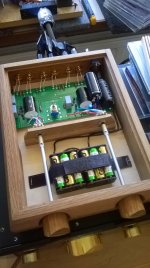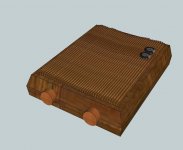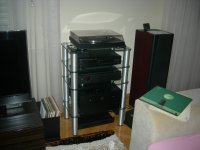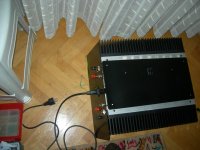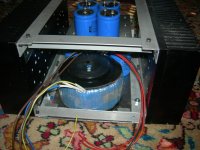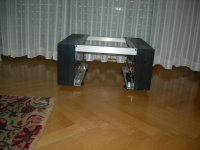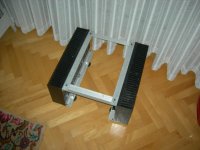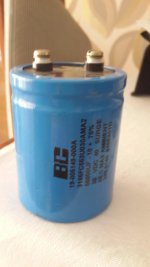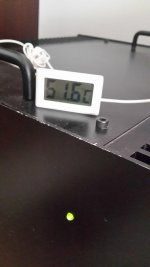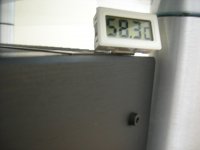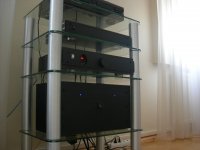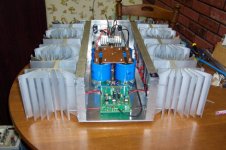Didn't have the wiring done before with posting #2815, but here's an inside pic.
The design changed a bit. I was first thinking of putting the power caps through the top cover like in the Sketchup pic, but after seing it live, I decided against that. So I had to put the caps laying down.
Also, I'll probably put in a stereo pot and make the other knob function as a souce selector switch.
The design changed a bit. I was first thinking of putting the power caps through the top cover like in the Sketchup pic, but after seing it live, I decided against that. So I had to put the caps laying down.
Also, I'll probably put in a stereo pot and make the other knob function as a souce selector switch.
Attachments
All your inputs have open loops.
Change them to twisted pairs.
Don't use the solder tag. Instead solder the Signal return to the end of the barrel right next to the signal pin.
If you are neat with pre-soldering the end of the barrel you can still screw the nut On and Off.
Change them to twisted pairs.
Don't use the solder tag. Instead solder the Signal return to the end of the barrel right next to the signal pin.
If you are neat with pre-soldering the end of the barrel you can still screw the nut On and Off.
Last edited:
Another non believer in close coupled signal pairs !
As Nelson Pass himself built that B1, (in post #2825) I suggest you keep your opinions of Pass/Firstwatt amplifiers and components to yourself, as he is the authority.
I am not saying that i disagree that twisted pairs offer some possible improvements in noise rejection, I was simply suggesting that someone who knows a little about amp building seems to think it is not absolutely mandatory on his commercially produced units, so your position may be somewhat overstated. I would imagine that Nelson could show that his production units are extremely quiet and do not suffer any extreme noise issues as a result of non twisted input wires.
That being said, you were offering advice to someone using a non shielded, wooden case, and in that particular scenario, I would be taking extra precautions when it came to protecting input wiring from external noise.
That being said, you were offering advice to someone using a non shielded, wooden case, and in that particular scenario, I would be taking extra precautions when it came to protecting input wiring from external noise.
I am not saying that i disagree that twisted pairs offer some possible improvements in noise rejection, I was simply suggesting that someone who knows a little about amp building seems to think it is not absolutely mandatory on his commercially produced units, so your position may be somewhat overstated. I would imagine that Nelson could show that his production units are extremely quiet and do not suffer any extreme noise issues as a result of non twisted input wires.
That being said, you were offering advice to someone using a non shielded, wooden case, and in that particular scenario, I would be taking extra precautions when it came to protecting input wiring from external noise.
A well balanced and quite fair response to a posting that I certainly thought was well intended. Thank you.
Best Regards,
TerryO
Hi there guys!
Yes, I've also aknowlaged that same picture and pretty much subscrib to buzzforb's saying. After all the signal wires are quite short and the power supply is external (excluding the batterries of course).
But also, as a mater of fact, I have been doing exactly what Andrew says with my other projects. Only this time I had only about 10 cm left of the signal wire I wanted to use, so I had to do it this way for now.
Only this time I had only about 10 cm left of the signal wire I wanted to use, so I had to do it this way for now.
I'll probably do the wiring again (and ditch the solder tabs) once I get some more of that said wire. But even now I dont detect any noise, smear or such.
Yes, I've also aknowlaged that same picture and pretty much subscrib to buzzforb's saying. After all the signal wires are quite short and the power supply is external (excluding the batterries of course).
But also, as a mater of fact, I have been doing exactly what Andrew says with my other projects.
I'll probably do the wiring again (and ditch the solder tabs) once I get some more of that said wire. But even now I dont detect any noise, smear or such.
My Aleph X
its my aleph-X.
18 v rail. 8 x IRFP240 matched. (one channel)
5.4 A bias current/ch
Power Supply;
1000 VA 2 x 15 v + 2 x 15 v
2 x 35 A 1000v bridge
12 x 55.000 uF cap. CRCC filter. (3 x 55.000 uF one/ch - one/rail)
heatsink ~52 C. after 2 hours work.
its my aleph-X.
18 v rail. 8 x IRFP240 matched. (one channel)
5.4 A bias current/ch
Power Supply;
1000 VA 2 x 15 v + 2 x 15 v
2 x 35 A 1000v bridge
12 x 55.000 uF cap. CRCC filter. (3 x 55.000 uF one/ch - one/rail)
heatsink ~52 C. after 2 hours work.
Attachments
As Nelson Pass himself built that B1, (in post #2825) I suggest you keep your opinions of Pass/Firstwatt amplifiers and components to yourself, as he is the authority.
I am not saying that i disagree that twisted pairs offer some possible improvements in noise rejection, I was simply suggesting that someone who knows a little about amp building seems to think it is not absolutely mandatory on his commercially produced units, so your position may be somewhat overstated. I would imagine that Nelson could show that his production units are extremely quiet and do not suffer any extreme noise issues as a result of non twisted input wires.
That being said, you were offering advice to someone using a non shielded, wooden case, and in that particular scenario, I would be taking extra precautions when it came to protecting input wiring from external noise.
A well balanced and quite fair response to a posting that I certainly thought was well intended. Thank you.
Best Regards,
TerryO
It does not matter who the Builder is, my statement still stands and is worth repeating.Hi there guys!
Yes, I've also aknowlaged that same picture and pretty much subscrib to buzzforb's saying. After all the signal wires are quite short and the power supply is external (excluding the batterries of course).
But also, as a mater of fact, I have been doing exactly what Andrew says with my other projects.Only this time I had only about 10 cm left of the signal wire I wanted to use, so I had to do it this way for now.
I'll probably do the wiring again (and ditch the solder tabs) once I get some more of that said wire. But even now I dont detect any noise, smear or such.
Another non believer in close coupled signal pairs
One either believes that open loops increase interference or one doesn't.
This applies to both input circuits, Receivers and to output circuits, Transmitters.
I suppose there are two camps those that close couple and those that don't.
Everyone that uses a multilayer board is a user of close coupled pairs, be it a PC, or TV, or Medical equipment, or measuring instrument, or audio/visual equipment.
This applies to both input circuits, Receivers and to output circuits, Transmitters.
I suppose there are two camps those that close couple and those that don't.
Everyone that uses a multilayer board is a user of close coupled pairs, be it a PC, or TV, or Medical equipment, or measuring instrument, or audio/visual equipment.
One either believes that open loops increase interference or one doesn't.
QUOTE]
I somehow would like to have a *like* button here......
I'm still running my Aleph 2's that I built about ten years ago. I never finished them all the way. They still need front panel and top plus anodizing. Now that I have more time I am going to finish these amps. They have worked flawlessly all these years and they are likely the coolest running Aleph's you'll ever encounter. Did anyone say too much heat sinking? Also, I still have my Aleph 30 and Mini Aleph.
Mark
Mark
Attachments
Last edited:
hello folks
after having struggled with my F5Turbo choke input edtion for some months I finally had a breakthrough thanx to 6L6 who helped me with a technical issue regarding the pots getting out of range.
now they´re finally stable after several months of fiddling
I very well understand why folks don´t combine choke input psus with class A amps...impossible to simulate...one rally has to do the experimenting the hard way
anyway here they are before theyre covered with their alu tubes and top covers
best
Leif

after having struggled with my F5Turbo choke input edtion for some months I finally had a breakthrough thanx to 6L6 who helped me with a technical issue regarding the pots getting out of range.
now they´re finally stable after several months of fiddling
I very well understand why folks don´t combine choke input psus with class A amps...impossible to simulate...one rally has to do the experimenting the hard way
anyway here they are before theyre covered with their alu tubes and top covers
best
Leif

Last edited by a moderator:
- Home
- Amplifiers
- Pass Labs
- Pictures of your diy Pass amplifier

